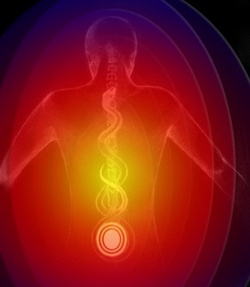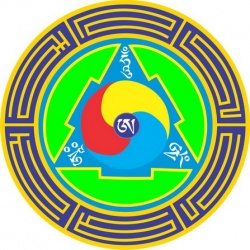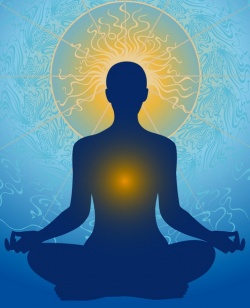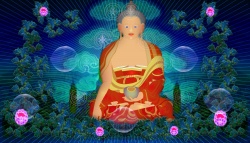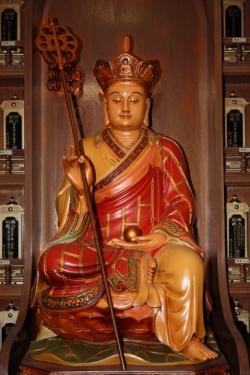Local deities
Although the contemplative elite may deny the real existence of gods and demons together with the rest of phenomenal existence, the majority of Buddhists have preserved indigenous religious beliefs and practices. It has already been noted how Mara, the manifestation of spiritual evil, was presented in the earliest literature in terms of local demonological beliefs. It is also the case that the early stupas and entrances to cave temples were decorated with local male and female deities (usually referred to as yakshas and yakshinis) who were seen as converted defenders of the new faith
1 The Thirteen Dralas of Tibet Robin Kornman This article was originally commissioned by the Council of the Makkyi Rabjam. The Dorje Dradül thangka depicts the Vidyådhara, the Venerable Chögyam Trungpa Rinpoche, as a warrior king in the manner of Gesar of Ling or the Rigden Kings of Shambhala. The diversity of the figures on the thangka express the special way that the Dorje Dradül combined teachings from many traditions.
At the top of the thangka are the three main gurus of the Kagyü and Nyingma traditions who appear in his Sådhana of the Embodiment of all the Siddhas (a.k.a. The Sådhana of Mahåmudrå ). Arranged above the central figures’ heads from shoulder to shoulder are dancing çåkinës appearing as heavenly musicians known as gandharvas. At the bottom of the thangka are three Buddhist dharma protectors. And ranged in a semicircle to his left, right, and below him are thirteen warriors in armor who seem to be emanations of Trungpa Rinpoche because they are outfitted like him. These are the thirteen dralas of Tibet.
When Khyentse Rinpoche and Sakyong Mipham Rinpoche designed the thangka, they put into it figures and motifs that represented the Dorje Dradül’s teachings in the West. So, for example, Trungpa Rinpoche’s way of combining Nyingma and Kagyü teachings is represented by the guru figures from his most famous sådhana. The protectors ranged at the bottom of the thangka reflect the dharmapålas, both male and female, which he invoked in the protection of his Vajradhatu centers. His Shambhala teachings are represented by the warrior style of the central figure and, of course, by the thirteen dralas.
Rinpoche’s teachings on the nature of dralas are found in the talks he gave at Kalåpa Assembly when he was giving commentary on the Shambhala termas. Who are the thirteen dralas? Actually, there are several answers to this question. Trying to figure out who they are exactly is complicated enough to lead you into confusion and bewilderment. Nevertheless, there are some common themes about these figures that can help to give you a sense of what they represent in your own experience when you practice. In reading about them you can let some of the details wash over you and just gain an intuitive sense of what you are inheriting from the lineage.
Dralas, or as we sometimes translate them, war gods, are a class of local deities from the non-Buddhist native religious practice of Tibet. If you ask a Tibetan, he or she might very well say that they are Bön deities, because this is the word that Buddhists informally use for non-Buddhist religion in Tibet. That answer, ho ever, would not be strictly accurate. Bön itself is a formal religion imported into Tibet, perhaps from an ancient kingdom to the West known as Shang Shung.
It is a religion with many scriptures, a definable dogma, and a complete system of metaphysics and meditation practice just like Buddhism. It is true that Bön scriptures mention dralas and other local deities a great deal, but it might be more accurate to say, as the Tibetan anthropologist R.A. Stein did, that the real home of belief in dralas is a religion with no name that constitutes the common occult beliefs of all Tibetans—no matter to what lineage, sect, or system they belong. In fact, Stein called it the “nameless religion.” One of the characteristic ceremonies of this religion is the lhasang, or smoke purification offering.
This is definitely a non-Buddhist ceremony, but it is performed by Buddhists and Bönpos alike, simply because everybody in Tibet believes in the war gods that are invoked by a lhasang and asked to descend down the column of juniper smoke. A lhasang may begin by mentioning Buddhas and bodhisattvas, if it is being chanted by a Kagyüpa or Nyingmapa, for example. But the principal invocations at the heart of the ceremony call upon the dralas, who are the next level down from the enlightened beings. A Bön ceremony might begin with the founders and enlightened beings of Bön. But these are an introduction to the core of a Bön lhasang, which will be invoking a list of more or less the same dralas as a Buddhist one. Actually, the main deities invoked by this ceremony have as a class a standard technical appellation; they are called the eight classes of deities, the lha degyé. The eight classes are a list of the main groups of non-Buddhist deities every Tibetan believes in, the local deities.
The list varies slightly from one tradition to another, but in general it includes the dralas as one of the eight classes. It also includes the lha (deities of the sky), the nyen (mountain gods), and the lu (någas or dragons). It also includes strange local classes such as the fascinating one-legged teurang, gods of gamblers who ride around on tornadoes. Sometimes all the eight classes are simply called dralas, because the name has also come to refer loosely to all native Tibetan gods. But as the name itself indicates, the term drala, when used precisely, denotes deities with a very specific function—practical protection of the individual. When dralas are thought of in this way—that is, as protectors—they are usually represented as armored men and women with weapons riding on horses, armed for our protection, divine bodyguards. This is the general picture one has of a drala. As Walter Scott would have said, “gallant champions, mounted bravely and armed richly.”
When the time comes to describe specific dralas and their exact characteristics, the picture changes. Each drala has its own proper name and a subcategory of war gods into which it falls as well as a specific, unique iconography. We will look at the naming and iconography of dralas later. But first, let us look at the word itself to gain a deeper appreciation of what it means. Dralas and Their Groups Most of what we know about the dralas comes to us from the texts of various lhasang ceremonies and from the Gesar Epic, where, as you will see, they play a role as characters. The list changes dramatically from one source to another, perhaps because there are actually two or three groups of dralas (called brotherhoods) that have thirteen members. Typically the lhasang liturgies give hierarchical lists of the deities being offered to and invited to descend down the column of smoke . Some groups have three members, some nine, some thirteen, some thirty-six. 3
Lhasangs usually begin by invoking the highest divine principles: buddhas, yidams, great bodhisattvas, and gurus. Next they invoke the local deities—dralas, wermas, and so on—and when they do this we learn about th e societies or brotherhoods of dralas. When the term drala is used to refer to one of these brotherhoods, it names a class of deities. But the word drala is also the proper name of one specific Tibetan god who perches invisibly on the right shoulder of warriors, protecting them against attacks. In fact, this is what the word literally means: “god against enemies.” The word dra (dgra) means “enemy.”
The word lha can have two meanings. When it is spelled lha , it means “god”; so in this sense a dralha is an “enemy god,” that is, a god who defends against enemies. But lha can also be spelled bla (meaning “above”). In that case, it is pronounced simply as “la” without the h sound, and the meaning of the compound is “above the enemy,” or as it is spoken about in Shambhala: The Sacred Path of the Warrior , “above any enemy or conflict . . . wisdom beyond aggression.” The presence of the b in bla and the peculiar accent of some Tibetans makes this often pronounced as “dab-la.” As the name of a particular spirit, Drala is part of a set of personal energies called “the five patron gods,” as mentioned in the “Invocation for Raising Windhorse.” The five patron gods occupy stations on the body of a warrior and are essential to his or her success in life. They are almost synonymous with one’s windhorse (lungta; rlung rta) and are sometimes called the “five patron gods of authentic presence.”
Authentic presence is a translation for the Tibetan word wangtang (dbang thang), which literally means the “field of power.” It can be thought of as a globe of invisible light or energy that surrounds a warrior or a saint. Tibetan thangkas represent it in cross section as a rainbow arc above the shoulders. When the five patron deities are fully vested on the body of the warrior, his or her windhorse is raised and the wangtang spreads open like an energy field projecting out from the body. What is the individual character of each of th e five patron gods? One list gives them this way: crown of the head—yul lha (yul lha; “country god”) right shoulder—dra lha (dgra lha; “enemy god”) right armpit—po lha (pho lha; “male god”) left armpit—mo lha (mo lha; “female god”) heart—sok lha (srog lha; “life-force god”) Yul lha is a very ancient class of deity sometimes associated with hunting. It is translated at times as “god of the chase.” Sometimes it is simply the word for the deity that rules a certain region.
The sok of sok lha is the famous Tibetan word for “life force.” The life force dwells in the heart of human beings. It is part of a list of three forces which, in native Tibetan lore, are essential to human life—sok, tse (tshe), and la, or life force, longevity energy, and soul. Sok is sometimes called sok marpo (srog dmar po), the “red life.” Without it the human body would become inanimate. Ts e is an energy which a person receives in a certain amount at birth. When the tse is all used up, a person dies of old age. 4 La is a complex of energies that is responsible for one’s sense of identity. Some scholars, influenced by the Chinese theory of multiple souls, call it a soul. The la can actually wander from a person’s body. In that case, one would become depressed, forgetful, and extremely vulnerable to illness.
Eventually, a person whose la has wandered will die. Therefore, there are important ceremonies in which you call the la back, even offering a “ransom” for its return. Actually, the famous Kagyü White Tårå practice that is done to extend one’s life is called “ransoming for the return of the la.” Dralas and Trauma All the energies and deities mentioned above are part of what you could call the Tibetan theory of trauma. When a person receives a sudden shock, it can scare these energies away from the body. If a person is terribly humiliated, the patron gods and perhaps the la itself will abandon the body. The so-called “interrogation techniques” the Americans used at Abu Ghraib prison in early 2004 to “soften up” prisoners would be seen by this tradition as an attempt to strip a person of their life force and protective spirits.
There are many famous stories of such goings on. For example, if one wishes to assassinate a king, it is felt that his patron deities, which must be very strong if he is a king, have to be driven away. The ancient Tibetan king Trigum Tsenpo was defeated by his minister Long Ngam after the minister got his dra lha and po lha to leave the king’s shoulder and armpit. In the Gesar epic the young Gesar is attacked by a Bönpo shaman named Anye Gompa Råja. Anye begins his attack some distance from Gesar’s tent by shouting three PHAÛ ’s. The three shouts are designed to frighten away the protective gods that dwell on and around his body.
Being Gesar, he has more than mere ly the usual collection of patron gods and energies. He has four kindred gods who each command an army of emanational gods. In this passage Gesar is called Joru, the name he kept until he had won the horse race. Joru realizes Gompa Råja is about to attack and marshals his dralas, led by his four brother and sister dralas, into stones that will be used as weapons. Later in the epic he will acquire his armor and horse. Then these gods will live on his weapons, armor, and parts of his horse’s body. These articles and locations will be “supports” (ten; rten) for the dralas, physical objects that they use in order to manifest. Here is the passage where Gompa Råja mounts his mystical attack. Joru said, “Mother, the time has come for me to subjugate Anye Gompa Råja.
Could you please bring me four little pebbles?” She put four pebbles in his hand. He put one in front, one in back, and one each to the right and the left. [Then he called] elder brother, White Garuça Conch, younger brother Little Light Någa Serpent, sister Sparkling Radiant Light, and Lord Nyen Gedzo along with the Nine Brethren, the best of war gods. At that time they had not yet united with the actual supports for the war gods: armor, helmet, and weapons (which had not yet been gathered). So the war gods along with their retinue, using the pebbles as the meditative focal point, were brought into them. Anye Gompa Råja was coming from his retreat and approaching in three stages. When he shouted PHAÛ the first time, all the gods in the sky disappeared. But elder brother White Garuça Conch, surrounded by the 900 conch-armored ones, became 5 one with the pebble without being harmed. Again, as he moved one stage closer, Anye shouted another PHAÛ and all the någas below him disappeared.
But younger brother Little Light Någa Serpent along with his retinue of 900 remained firm. On seeing the tent, Anye shouted PHAÛ again and all the nyen in the middle realm disappeared. However, Gedzo and his retinue of 360 remained firm. At that time Joru focused his mind and called to the gods. Then all the war gods returned like a flurry of snow. There was a blizzard of dharmapålas and wermas like lightning bolts flashing everywhere. At the moment that the heretic Gompa Råja arrived at the door, Joru quickly ran, scooping up the four pebbles and threw them. According to Anye’s perception, he saw a white man with 900 conch-armored ones, a blue man with 900 turquoise- armored ones, a yellow man with 360 gold-armored ones, and an army of çåkinës 900 strong chasing him. Without looking back he ran away.
As this passage shows, the dralas can take many forms and rest in all sorts of physical objects. When Joru loads them into stones and throws them at Anye, the shaman actually sees the dralas attacking him in their iconographic form. Being a special, supreme being, Gesar has special dralas as well. The four mentioned here act like patron gods, but are more powerful and more specific. They are called brother and sister, because some of them descended from heaven and entered into the womb with him and were born with him. Others were drawn to him by their previous vows and remain around him. Later, when he gains his divine armor from Mount Magyal Pomra where it is buried, and his magical horse from the no-man’s-land where it lives at his birth, these gods will rest in these objects.
Each of them is accompanied by armies of other dralas who would appear like them. When Anye tried to frighten them away, it worked for some of the many dralas on his body or hovering about, but the most powerful ones remained firm. Ordinarily the three scary PHAÛ ’s would have been enough to disarm the victim of Anye’s attack. But since it is Gesar, a person of perfect power, dignity, windhorse, and authentic presence, they all return in an instant, reinstalling themselves in such a rush that they form a mass of returning war gods like a flurry of snow. This is what a warrior would have to do in the world of Tibetan magic.
After he had received the shock or trauma, he would focus his mind, raise windhorse, straighten himself psychologically, and call his patron deities back instantly. In his book on Tibetan protective deities, Nebesky-Wojkowicz describes the iconography of the five patron gods. The mo lha is a beautiful young girl wearing white and blue silk and a jeweled diadem. She rides a white deer and holds a divination arrow and a mirror. Her name is Machik Palgyi Lhamo, Only Mother Glorious Goddess. She emanates goddesses like herself from her body. Sok lha is represented as a white man with a powerful body, riding a black horse with white hooves. He has a golden helmet and cuirass and wields a lance with white pennants and a snare. His body emanates countless “gods of male beings.”
